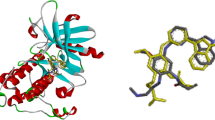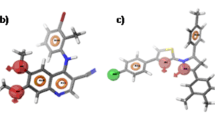Abstract
The most common pharmacologic approaches to inhibiting EGFR have been to develop small-molecule inhibitors which exert their effects at the intracellular portion of the receptor to prevent tyrosine kinase phosphorylation and subsequent activation of signal transduction pathways. A non-covalent molecular docking study was carried-out between 119 NCI anticancer compounds with receptor tyrosine kinase domain from epidermal growth factor receptor (PDB ID: 1M14), out of which 11 compounds had binding energy calculated with monte Carlo algorithm in ICM-pro Molsoft < − 25.25 kcal/mol. was found to have highest binding affinity with a reported value of − 32.832 kcal/mol, while Asaley had the overall least value (− 1.977 kcal/mol). The binding energy of all the compounds were found to be greatly influenced by the number and type of hydrogen bond interaction present between the ligands and the receptor except in few instances involving 5-flourouracil and mitomycin. A detailed description of the interactions of EGFR inhibitors developed can assist in the design of a more potent, more specific cytostatic drugs that can arrest tumor growth and cause tumor regression.












Similar content being viewed by others
References
Abagyan R, Totrov M (1994) Biased probability Monte Carlo conformational searches and electrostatic calculations for peptides and proteins. J Mol Biol 235(3):983–1002
An J, Totrov M, Abagyan R (2005) Pocketome via comprehensive identification and classification of ligand binding envelopes. Mol Cell Proteom 4(6):752–761
Engebraaten O, Bjerkvig R, Pedersen PH, Laerum OD (1993) Effects of EGF, BFGF, NGF and PDGF (bb) on cell proliferative, migratory and invasive capacities of human brain-tumour biopsies in vitro. Int J cancer 53(2):209–214
Evans DA (2014) History of the Harvard ChemDraw project. Angew Chem Int Ed 53(42):11140–11145
Fabbro D, Ruetz S, Buchdunger E, Cowan-Jacob SW, Fendrich G, Liebetanz J, Chaudhuri B (2002) Protein kinases as targets for anticancer agents: from inhibitors to useful drugs. Pharmacol Ther 93(2):79–98
Fernández-Recio J, Totrov M, Abagyan R (2002) Soft protein–protein docking in internal coordinates. Protein Sci 11(2):280–291
Fernández-Recio J, Totrov M, Abagyan R (2003) ICM-DISCO docking by global energy optimization with fully flexible side-chains. Proteins Struct Funct Bioinf 52(1):113–117
Franklin WA, Veve R, Hirsch FR, Helfrich BA, Bunn PA (2002). Epidermal growth factor receptor family in lung cancer and premalignancy. In: Paper presented at the seminars in oncology
Goldman CK, Kim J, Wong W, King V, Brock T, Gillespie G (1993) Epidermal growth factor stimulates vascular endothelial growth factor production by human malignant glioma cells: a model of glioblastoma multiforme pathophysiology. Mol Biol Cell 4(1):121–133
Hehre WJ, Huang WW (1995) Chemistry with computation: an introduction to SPARTAN: Wavefunction, Inc, Irvine
Huang S, Ingber DE (1999) The structural and mechanical complexity of cell-growth control. Nature Cell Biol 1(5):E131–E138
Li Z, Wan H, Shi Y, Ouyang P (2004) Personal experience with four kinds of chemical structure drawing software: review on ChemDraw, ChemWindow, ISIS/Draw, and ChemSketch. J Chem Inf Comput Sci 44(5):1886–1890
MolSoft I (2000) 2.8 program manual. MolSoft LLC, San Diego
Oliveira-Cunha M, Newman WG, Siriwardena AK (2011) Epidermal growth factor receptor in pancreatic cancer. Cancers 3(2):1513–1526
Passegué E, Jamieson CH, Ailles LE, Weissman IL (2003) Normal and leukemic hematopoiesis: are leukemias a stem cell disorder or a reacquisition of stem cell characteristics? Proc Natl Acad Sci 100(suppl 1):11842–11849.s
Petit A, Rak J, Hung M-C, Rockwell P, Goldstein N, Fendly B, Kerbel RS (1997) Neutralizing antibodies against epidermal growth factor and ErbB-2/neu receptor tyrosine kinases down-regulate vascular endothelial growth factor production by tumor cells in vitro and in vivo: angiogenic implications for signal transduction therapy of solid tumors. Am J Pathol 151(6):1523
Reya T, Morrison SJ, Clarke MF, Weissman IL (2001) Stem cells, cancer, and cancer stem cells. Nature 414(6859):105–111
Salvati ME, Balog A, Shan W, Wei DD, Pickering D, Attar RM, Weinmann R (2005) Structure based approach to the design of bicyclic-1H-isoindole-1, 3 (2H)-dione based androgen receptor antagonists. Bioorg Med Chem Lett 15(2):271–276
Shibata T, Kawano T, Nagayasu H, Okumura K, Arisue M, Hamada J-I, Hosokawa M (1996) Enhancing effects of epidermal growth factor on human squamous cell carcinoma motility and matrix degradation but not growth. Tumor Biol 17(3):168–175
Soverini S, Gnani A, Colarossi S, Castagnetti F, Abruzzese E, Paolini S, Gozzini A (2009) Philadelphia-positive patients who already harbor imatinib-resistant Bcr-Abl kinase domain mutations have a higher likelihood of developing additional mutations associated with resistance to second-or third-line tyrosine kinase inhibitors. Blood 114(10):2168–2171
Stamos J, Sliwkowski MX, Eigenbrot C (2002) Structure of the epidermal growth factor receptor kinase domain alone and in complex with a 4-anilinoquinazoline inhibitor. J Biol Chem 277(48):46265–46272
Viswanadhan VN, Ghose AK, Revankar GR, Robins RK (1989) Atomic physicochemical parameters for three dimensional structure directed quantitative structure-activity relationships. 4. Additional parameters for hydrophobic and dispersive interactions and their application for an automated superposition of certain naturally occurring nucleoside antibiotics. J Chem Inf Comput Sci 29(3):163–172
Weisberg E, Manley PW, Cowan-Jacob SW, Hochhaus A, Griffin JD (2007) Second generation inhibitors of BCR-ABL for the treatment of imatinib-resistant chronic myeloid leukaemia. Nat Rev Cancer 7(5):345–356
Wilhelm SM, Carter C, Tang L, Wilkie D, McNabola A, Rong H, McHugh M (2004) BAY 43-9006 exhibits broad spectrum oral antitumor activity and targets the RAF/MEK/ERK pathway and receptor tyrosine kinases involved in tumor progression and angiogenesis. Cancer Res 64(19):7099–7109
Zwick E, Bange J, Ullrich A (2002) Receptor tyrosine kinases as targets for anticancer drugs. Trends Mol Med 8(1):17–23
Acknowledgements
The authors would like to thank Andrew Orry, for granting us the license for ICM-Pro molsoft program we adopted for this docking study.
Author information
Authors and Affiliations
Corresponding author
Rights and permissions
About this article
Cite this article
Arthur, D.E., Uzairu, A., Mamza, P. et al. Structure-based optimization of tyrosine kinase inhibitors: a molecular docking study. Netw Model Anal Health Inform Bioinforma 7, 9 (2018). https://doi.org/10.1007/s13721-018-0170-4
Received:
Revised:
Accepted:
Published:
DOI: https://doi.org/10.1007/s13721-018-0170-4




